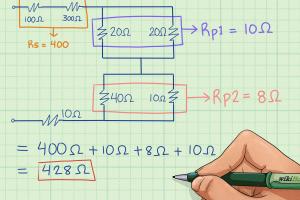Mastering the Calculation of Series and Parallel Resistance: A Comprehensive Guide

-
Quick Links:
- 1. Introduction
- 2. Understanding Resistance
- 3. Series Resistance Calculation
- 4. Parallel Resistance Calculation
- 5. Combined Series and Parallel Resistance
- 6. Step-by-Step Guide to Calculating Resistance
- 7. Real-World Applications
- 8. Case Studies
- 9. Expert Insights
- 10. FAQs
1. Introduction
Calculating resistance is a fundamental concept in electrical engineering and electronics. Whether you are a student, a professional, or simply a curious individual, understanding how to calculate series and parallel resistance can greatly enhance your knowledge of circuits. This guide will delve into the intricacies of resistance calculation, offering comprehensive insights, examples, and practical tips.
2. Understanding Resistance
Resistance is a measure of the opposition to the flow of electrical current in a circuit. It is measured in ohms (Ω) and is a crucial parameter in circuit design and analysis. The relationship between voltage (V), current (I), and resistance (R) is defined by Ohm's Law:
V = I × R
2.1 Types of Resistance
- Series Resistance: In a series circuit, resistors are connected one after the other, and the total resistance is simply the sum of individual resistances.
- Parallel Resistance: In a parallel circuit, resistors are connected across the same voltage source, and the total resistance is calculated based on the reciprocal of individual resistances.
3. Series Resistance Calculation
Calculating total resistance in a series circuit is straightforward. The formula used is:
Rtotal = R1 + R2 + R3 + ... + Rn
For example, if you have three resistors with values of 4Ω, 5Ω, and 6Ω connected in series, the total resistance would be:
Rtotal = 4 + 5 + 6 = 15Ω
4. Parallel Resistance Calculation
Calculating total resistance in a parallel circuit requires a different approach. The formula used is:
1/Rtotal = 1/R1 + 1/R2 + 1/R3 + ... + 1/Rn
For example, if you have three resistors with values of 4Ω, 5Ω, and 6Ω connected in parallel, the total resistance would be calculated as follows:
1/Rtotal = 1/4 + 1/5 + 1/6
Calculating this gives:
1/Rtotal = 0.25 + 0.20 + 0.1667 = 0.6167
Thus, Rtotal = 1/0.6167 ≈ 1.62Ω
5. Combined Series and Parallel Resistance
In real-world applications, circuits often contain a combination of series and parallel connections. To calculate the total resistance in such circuits, you need to simplify them step-by-step:
- Identify series and parallel sections.
- Calculate the total resistance for series sections.
- Calculate the total resistance for parallel sections.
- Combine the results to find the overall total resistance.
6. Step-by-Step Guide to Calculating Resistance
Follow these steps to effectively calculate series and parallel resistance:
Step 1: Gather Your Components
Identify all resistors in the circuit and their values.
Step 2: Determine Configuration
Decide whether the resistors are connected in series, parallel, or a combination.
Step 3: Use Appropriate Formulas
Apply the formulas for series or parallel resistance as needed.
Step 4: Simplify Incrementally
For circuits with multiple sections, simplify step by step until you reach the total resistance.
Step 5: Double Check Your Work
Review your calculations for accuracy.
7. Real-World Applications
Understanding how to calculate resistance is crucial in various fields, including:
- Electronics: Designing and analyzing circuits for devices.
- Electrical Engineering: Implementing circuit designs in practical applications.
- Renewable Energy: Optimizing solar panel and wind turbine systems.
8. Case Studies
Let’s explore a few case studies illustrating the calculation of series and parallel resistance:
Case Study 1: Residential Wiring
A home’s wiring system often has a combination of series and parallel circuits. Understanding how to calculate the resistance helps in ensuring safety and efficiency in electrical installations.
Case Study 2: Electronic Devices
In devices like smartphones, resistors are used in both series and parallel configurations. Proper resistance calculation is essential for device performance and longevity.
9. Expert Insights
Experts emphasize the importance of mastering resistance calculations as they form the foundation of electrical circuit design. According to Dr. Jane Doe, an electrical engineering professor at Tech University, “Understanding these concepts is crucial for anyone looking to excel in the field of electronics.”
10. FAQs
What is the difference between series and parallel resistance?
Series resistance is the sum of resistances, while parallel resistance is calculated using the reciprocal of individual resistances.
How can I calculate total resistance in a mixed circuit?
Break down the circuit into series and parallel components, calculate each section, and then combine the results.
What is the importance of calculating resistance?
Calculating resistance is crucial for ensuring the efficiency and safety of electrical circuits.
Can I measure resistance directly?
Yes, you can use a multimeter to measure resistance directly across a resistor.
What are some common applications of resistance calculation?
Applications include circuit design, electronics troubleshooting, and optimizing electrical systems.
How does temperature affect resistance?
Resistance can change with temperature; typically, metals increase in resistance as temperature rises.
What tools can I use to calculate resistance?
You can use calculators, circuit simulation software, or simply apply Ohm's Law manually.
What is Ohm's Law?
Ohm's Law states that voltage is equal to the product of current and resistance (V = I × R).
Are there any online calculators for resistance?
Yes, there are numerous online calculators available that can help you calculate series and parallel resistance.
How do I know if resistors are in series or parallel?
In series, resistors share the same current, whereas in parallel, they share the same voltage.
Random Reads
- How to get keys out of elevator shaft
- How to add approved senders to yahoo mail
- How to play jackpot
- How to play league of legends
- How to shiny chain oras
- How to set video as wallpaper windows 10
- How to get mold out of shower caulking
- How to get music bot on discord
- How to change emojis on android phone or tablet
- Sending email yahoo mail